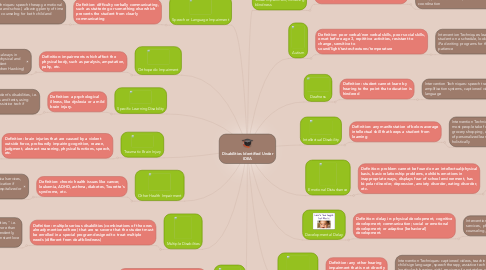
1. Autism
1.1. Definition: poor verbal/non verbal skills, poor social skills, onset before age 3, repititive activities, resistant to change, sensitive to sound/light/tastes/textures/temperature
1.1.1. Intervention Techniques: learn about autism, keep student on a schedule, look into "assistive tech," i.e. iPad writing programs for those who don't speak, have patience
1.1.1.1. Case study
2. Deaf-blindness
2.1. Definition: has problems both seeing and hearing, affects schooling to the degree that must be put into special program for both disabilities
2.1.1. Intervention Techniques: early on, teach student sign language, use speech therapy to help student learn about sound
2.1.1.1. Interesting fact: Helen Keller, a famous deaf/blind, learned to speak in her later years.
3. Deafness
3.1. Definition: student cannot learn by hearing to the point that education is hindered
3.1.1. Intervention Techniques: speech training, amplification systems, captioned videos, sign language
3.1.1.1. Case Study
4. Developmental Delay
4.1. Definition: delay in: physical development, cognitive development; communication; social or emotional development; or adaptive [behavioral] development.
4.1.1. Intervention Techniques: assistive tech, medical services, physical therapy, nutrition services, counseling, speech therapy, etc.
5. Emotional Disturbance
5.1. Definition: problem cannot be found on an intellectual/physical basis, basic relationship problems, exhibits emotions in inappropriate ways, displays fear of school environment, has bi-polar disorder, depression, anxiety disorder, eating disorder, etc.
5.1.1. Intervention Techniques: cater to the student's specific disorder (see link for overview of common disorders)
6. Hearing Impairment
6.1. Definition: any other hearing impairment that is not directly "deaf"
6.1.1. Intervention Techniques: captioned videos, teaching the child sign language, speech therapy, assistive tech (particularly hearing aids), services of a notetaker or interpreter
7. Intellectual Disability
7.1. Definition: any manifestation of below average intellectual skill that keeps a student from learning
7.1.1. Intervention Techniques: concentrate on life skills (everyday things most people take for granted, ex. taking public transportation, grocery shopping, etc. Also, give concrete examples, provide lots of personalized learning, focus on building up the student holistically
7.1.1.1. Case study
8. Multiple Disabilties
8.1. Definition: multiple serious disabilities (combinations of the ones already mentioned here) that are so severe that the student must be enrolled in a special program designed to treat multiple needs (different from deaf-blindness)
8.1.1. Intervention Techniques: help child with "Major Life Activities," i.e. walking, talking, even breathing, encourage child to do more than thought possible, like completing chores or acting independently, keep child socialized and, most importantly, give them constant love and care
9. Orthopedic Impairment
9.1. Definition: impairments which affect the physical body, such as paralysis, amputation, palsy, etc.
9.1.1. Intervention Techniques: teach with physical handicap always in mind, teach coordination along with lesson plan, use physical and occupational therapists, use assistive tech to help student communicate it paralysis makes it difficult to (like Stephen Hawking)
10. Other Health Impairment
10.1. Definition: chronic health issues like cancer, leukemia, ADHD, asthma, diabetes, Tourette's syndrome, etc.
10.1.1. Intervention Techniques: seek appropriate medical services, make sure child has access to appropriate medication if necessary, allow child to have private tutor is hospitalized or unable to attend school due to disability,
11. Specific Learning Disability
11.1. Definition: a psychological illness, like dyslexia or a mild brain injury.
11.1.1. Intervention Techniques: cater to student's disabilities, i.e. providing more time on assignments and tests, using audio over visual or vice versa, use assistive tech if possible
11.1.1.1. Case Study
12. Speech or Language Impairment
12.1. Definition: difficulty verbally communicating, such as stuttering or something else which prevents the student from clearly communicating
12.1.1. Intervention Techniques: speech therapy, emotional support at home and school, allowing plenty of time for school work, counseling for both child and parents
12.1.1.1. Case Studies
13. Traumatic Brain Injury
13.1. Definition: brain injuries that are caused by a violent outside force, profoundly impairing cognition, reason, judgment, abstract reasoning, physical functions, speech, etc.
13.1.1. Intervention Techniques: track child's treatment, seek advice from others with TBI, allow more time for school/homework, have patience when re-learning skills, enroll in pertinent therapies to help recover skills lost
14. Visual Impairment, including blindness
14.1. Definition: any impairment in vision that negatively affects education, be it partial or full and with/without aid.
14.1.1. Intervention Techniques: seek medical attention as soon as possible, train the child to use all senses by sensory stimulation (in case the eye does not heal, the child will be able to still cope with the world through the remaining 4 senses), use assistive tech, teach the child Braille, help child with motor coordination
14.1.1.1. Case Study

